School Streets Guide
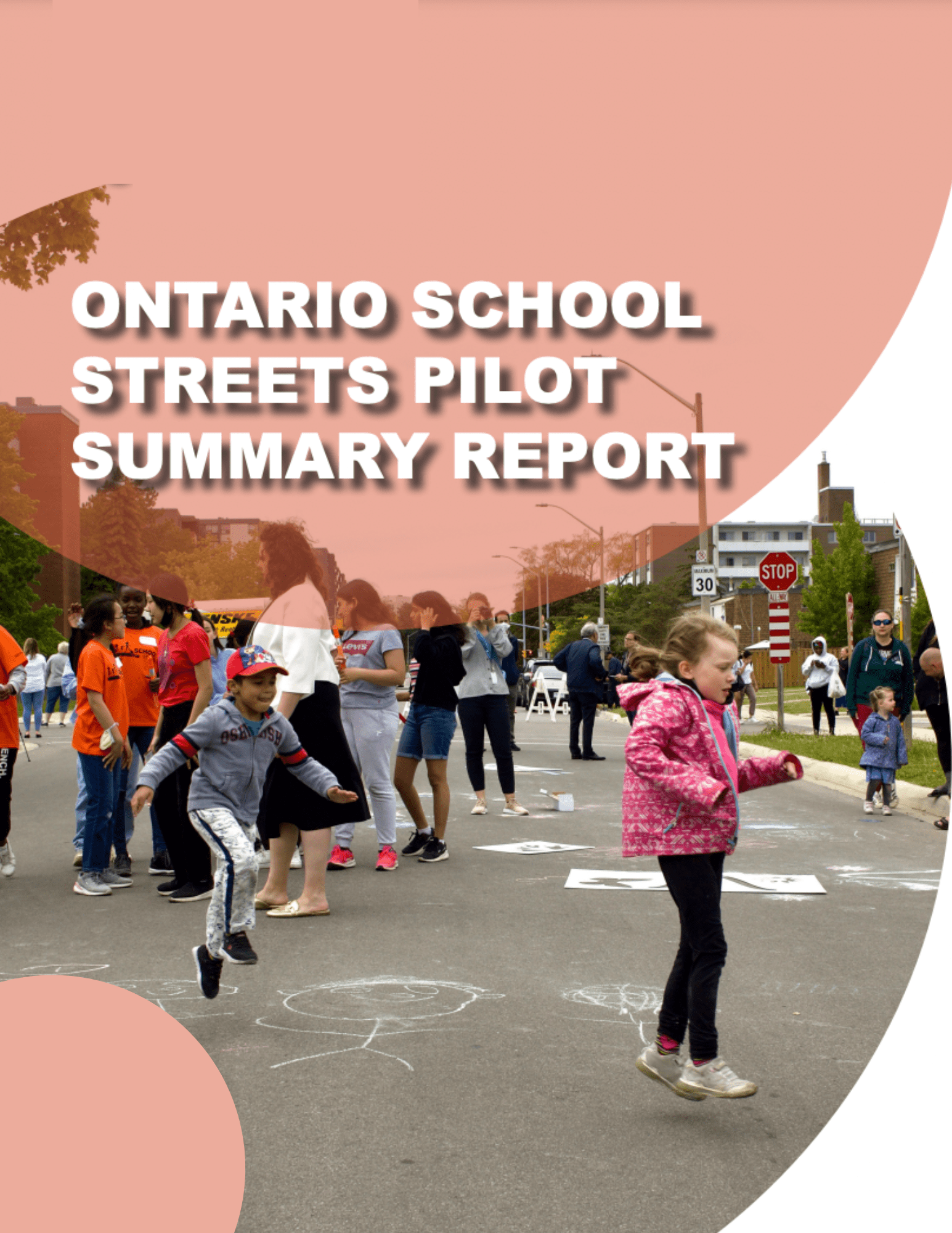
Report
Ontario School Streets Pilot Project Summary Report
Pilot results, key findings, and recommendations for School Streets implementation and expansion
meters of School Streets
School Streets piloted
days of School Streets
Project
The OSSP project began in September 2021 and was completed in June 2022. The project was coordinated by 8 80 Cities, who provided technical assistance, facilitated peer-to-peer coaching and knowledge exchange, and general project guidance. The key goals of the project were to:
- Increase active school travel
- Spark conversations about Vision Zero and road safety
- Continue the momentum of School Streets
- Reduce traffic congestion around schools
- Provide a safe and fun place for children to start and end their day
- Encourage municipalities to provide additional funding
The project proceeded in three key phases, Phase 1 (May 2021 – May 2022) for planning, Phase 2 (May – June 2022) for implementation and monitoring, and Phase 3 (June – September 2022) for facilitating evaluation and knowledge sharing.
Case Study 1: Hamilton
OBJECTIVE
The Hamilton pilot had five main objectives, including the goal to increase active travel and reduce car travel during the pilot, create more accessible public space for active transportation and play, connect the pilot to other initiatives at schools and the City of Hamilton, increase awareness of School Streets, and make the pilot scalable and adaptable to other schools.
OVERVIEW & PROGRAMMING
The School Street in Hamilton took place at Strathcona Elementary School through the City of Hamilton’s directive. For 30 minutes every Tuesday morning in June, the City of Hamilton used a combination of traffic pylons, road closed signs, volunteers, and service vehicles to operate the street closure. Accordingly, no vehicles were permitted to enter the space, making this a “hard” closure. On the first day, families came with hula hoops, skipping ropes, and games to use on the School Street. In addition, the team coordinated air quality programming in partnership with Green Venture.
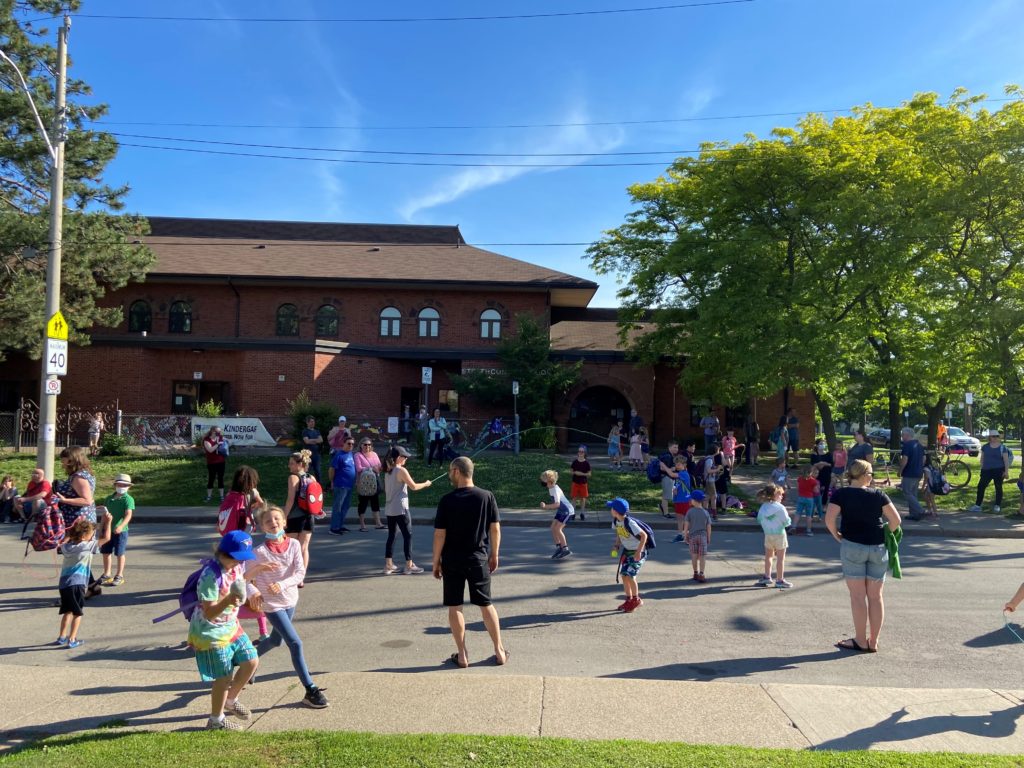
Families playing in the School Street at Strathcona Elementary School. (photo by: City of Hamilton)
RESULTS
The School Streets project resulted in a 7% increase in active travel to school (5% increase in walking, 1% increase in biking, 1% increase in wheeling), and a 9% decrease in vehicle use. The community response to this School Street was overwhelmingly positive, with one parent stating:
“We’d definitely like to see this repeated as much as we could in the future. Perhaps it could be seasonal for spring and summer.” – Julia Lillicrop, a parent, and president of the Home & School Association for Strathcona Elementary School
The community embraced the initiative, suggesting the possibility of implementing longer term School Streets in Hamilton in the future.
Case Study 2: Markham
OBJECTIVE
The School Streets pilot in Markham had five main objectives; including the goal to be inclusive and accessible to all users, improve community safety, educate community members about the benefits of active transportation, prioritize sustainability, and generate a fun space for the entire community.
OVERVIEW & PROGRAMMING
The School Street was launched at John McCrae Public School through a collaboration between the Markham Team of York Regional District School Board (YRDSB) and the City of Markham staff. Every Wednesday in May 2022, the School Street operated for an hour in the morning and afternoon. To close the street, the city implemented lightweight barricades, ‘road closed’ signs, orange pylons, and the York Region Police parked their cars at the School Street entrances. The only formal programming occurred on launch day, when the school trustee, the mayor of Markham, and city councillors joined the school to celebrate the program’s launch.
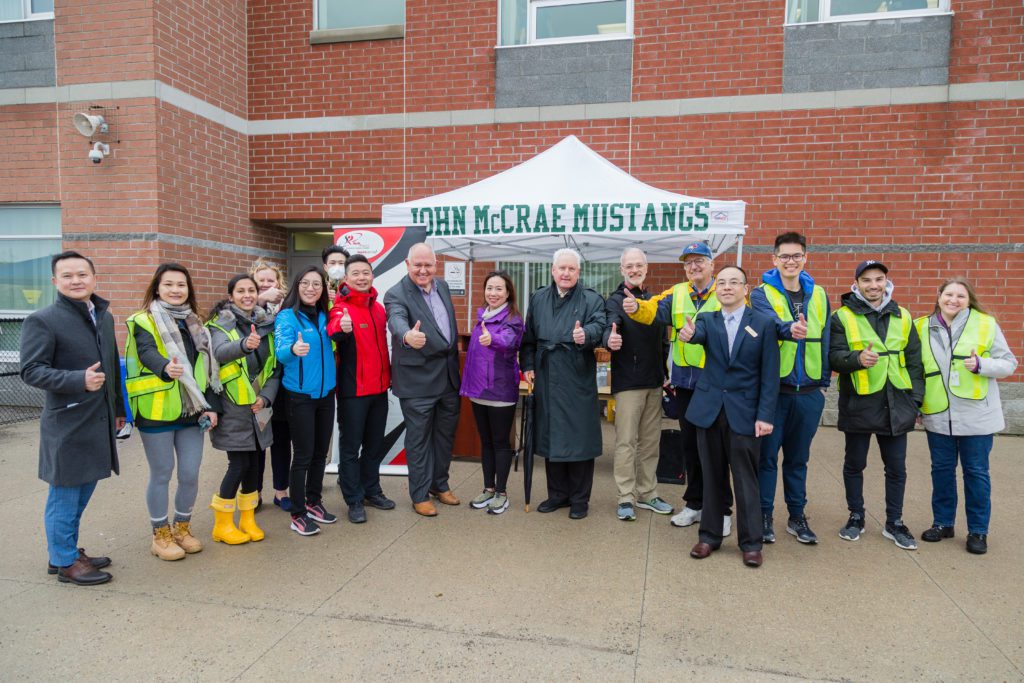
Elected officials, organizers, and community members gathered at John McCrae PS for the launch of the School Streets pilot (Photo: YRDSB)
RESULTS
The School Streets project resulted in a 6% increase in active travel to school (3% increase in walking, 1% increase in walking part way, and 2% increase in wheeling) and an overall decrease in dangerous driving behaviour (illegal parking, U-turn instances, speeding in school zones). After the pilot, 44% of students said that they would like the School Street to continue, and 60% of residents stated their approval of more School Streets programs in the future. This School Streets pilot created a strong foundational relationship between the school board and the City of Markham, with both groups expressing their intentions to collaborate on active school projects again in the future.
Case Study 3: Mississauga
OBJECTIVE
The School Streets pilot in Mississauga had four main objectives; to increase active travel, increase investment in active school travel programs, create more accessible public spaces for play, and increase awareness and acceptance of School Streets.
OVERVIEW & PROGRAMMING
Two separate School Streets pilots were launched in Mississauga. One was held at Hillside Public School and the other took place in front of a shared space between St. Alfred Separate School and Brian W. Fleming Public School. The planning of these two School Streets was a collaborative effort between the City of Mississauga, members from the Region of Peel, the school boards, Mississauga’s Traffic Safety Council, and the local student transportation consortium. Every day from May 9-27th, the School Street in front of Hillside PS operated for 35 minutes in the morning and for 50 minutes in the afternoon. The second School Street in Mississauga operated every day from May 16th-June 3rd for 50 minutes after school. Both streets were closed with lightweight barricades, ‘road closed’ signs, and volunteers located at each end of the closure. The School Streets at Hillside PS and at St. Alfred and Brian W. Fleming organized programming that corresponded with weekly themes. These themes included road safety, health and wellness, and the environment. To address concerns of food security, the programming at St. Alfred and Brian W. Fleming also included daily healthy snacks for students to grab as they left school in the afternoon.
RESULTS
The School Streets project at Hillside PS led to a 20% increase in active travel to school, with the number of students choosing to walk, wheel, or roll to school rising from 49% to 69%. The school recorded a 7% increase in active school travel from pre-pilot levels even two weeks after the pilot. In addition, there were 3.3 times more cyclists on the road, 40% less vehicle traffic in the morning, and 33% less vehicle traffic in the afternoon. The School Streets project at St. Alfred and Brian W. Fleming led to a 4% increase in active travel to school, with the number of students choosing to walk, wheel, or roll to school rising from 56% to 60%. In addition, there were 2 times more cyclists on the road, and an average of 85 fewer cars on the road. After the completion of these pilot programs, the three schools were awarded $500 by the Mississauga Traffic Safety Council to promote further active school travel initiatives in their communities. Hillside PS even requested an additional bike rack to accommodate the growing number of students choosing to bike to and from school.
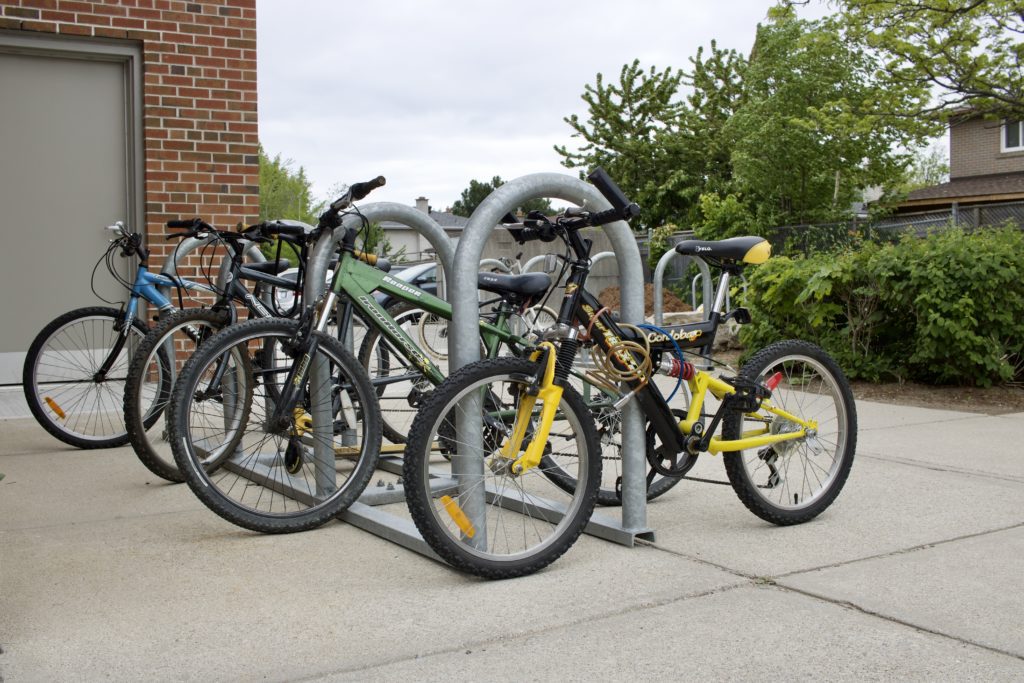
Full bike racks at St. Alfred (photo by: Green Communities Canada).
Overall, the acceptance of School Streets increased in the communities. Prior to the pilot implementation, 78% of community members refused the idea of establishing a School Street. After the pilot, this number dropped by 40%, down to 38%. These projects also gained significant media coverage, with over 650,000 reads on news article highlights, and reached over 250,000 individuals on Twitter and Facebook.
Case Study 4: Kingston
OBJECTIVE
The School Streets pilot in Kingston had four main objectives; to increase active transportation to and from school, improve safety in and around the school zone, provide opportunities for children to practice independent travel, and to raise awareness on the benefits of active school travel.
OVERVIEW & PROGRAMMING
The School Street was launched at Winston Churchill Public School as part of a larger research project, “Levelling the Playing Fields” led by researchers at Queens University and the University of Montreal. The project researchers collaborated with the Kingston Coalition for Active Transportation (KCAT) to develop the pilot, who then implemented the School Street in partnership with the City of Kingston. This School Street ran every morning and afternoon for the entire 2021-2022 school year, making it the longest School Streets program of the five pilots. The School Street was implemented for 25 minutes before and after school. To close the street, KCAT implemented lightweight barricades, road closure signs, and placed volunteers at both ends of the closure. There was no programming or activities on this School Street, as stakeholders requested the space to be used only for school travel purposes. However, KCAT organized a party for the final week of the program that included music, activities, and visits from city officials.
RESULTS
In October 2021, 65% of children pursued active travel to school (54% walked, 10% biked, 1% rolled), but by February, this figure dropped to 56%, with nobody choosing to bike or roll. This could have been a result of the colder weather during February, making active travel to school more difficult.
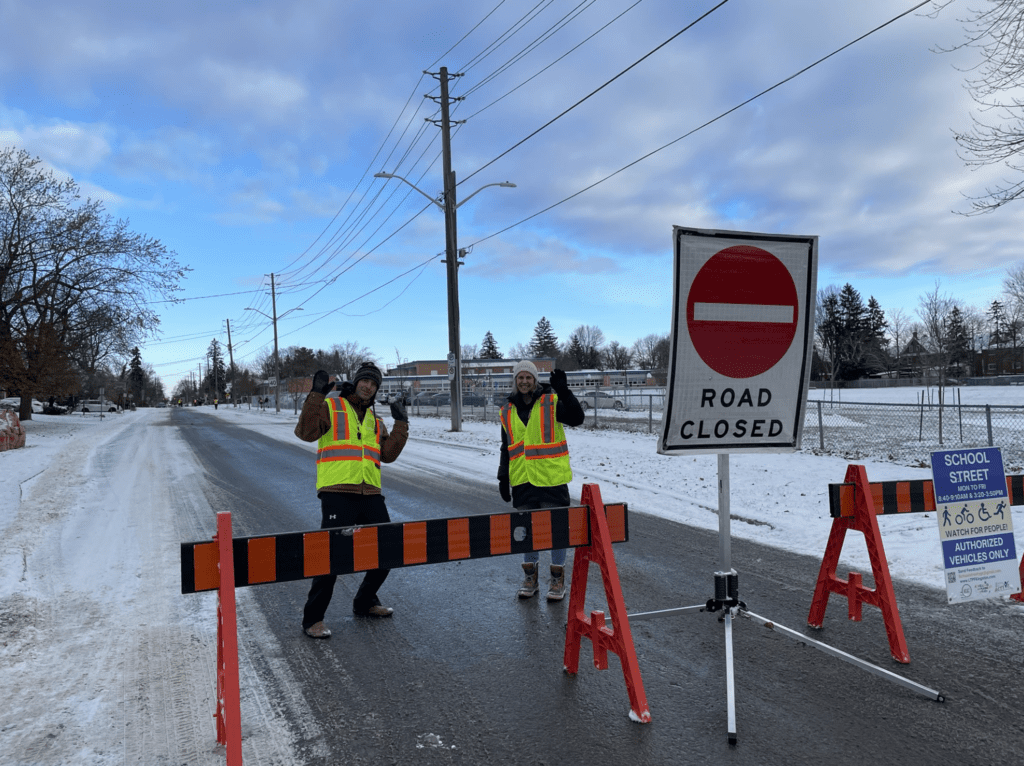
School Streets volunteers out on the first snowy day of the school year (photo by: Dr. Patricia Collins via Twitter)
The School Street, however, served other benefits, such as providing parents with a space to meet and mingle with other parents. The survey showed that 49% of parents found School Streets helpful in them meeting other parents. The School Streets program had an overall positive response from parents, with 76% in support of future School Streets projects, 44% claiming an improved sense of safety, and 46% stating an increase in their children’s interest in active travel. This pilot program in Kingston was brought to city council in June of 2022, where they approved the expansion of School Streets programs in the city. Winston Churchill PS was also approved to continue the program for the 2022-2023 school year. There is a lot of interest within the City of Kingston to expand School Streets, however, there is currently not enough funding or staff capacity to meet the demand.
Key Findings
- School Streets encourage walking and cycling
- School Streets support community building and social connection
- School Streets raise community awareness on road safety issues
- School Streets do not increase traffic on surrounding streets
- School Streets improve air quality in front of schools during the closure periods
- Each School Street is unique to each site
- A plan for project implementation is vital for reassuring critics
- There is no standardized municipal permit process for School Streets
- Municipal participation and support are keys factors for success
- Peer-to-peer support across School Street sites aid the planning process
- Communities are eager for more opportunities to use the road as public space
Recommendations
FOR PLANNING
- Assemble a team with both municipal and school involvement
- Incorporate the School Streets within existing active school travel programs
- Collaborate with like-minded groups across the country to share learnings to support implementation
FOR COMMUNITY ENGAGEMENT
- Ensure community engagement is meaningful, equitable, accessible, and begins as early in the planning phase as possible
FOR IMPLEMENTATION
- Animate the School Street space
FOR MUNICIPALITIES
- Simplify the permit process for temporary road closures
- Scale-up to longer-term pilots
- Incorporate School Streets into planning policies and/or strategies
The OSSP project provided the opportunity to test previous research findings, refine approaches, and develop key recommendations for scaling-up School Streets projects across the country.
If you’re looking to bring a School Street to a school near you and think we could help, please get in touch!
